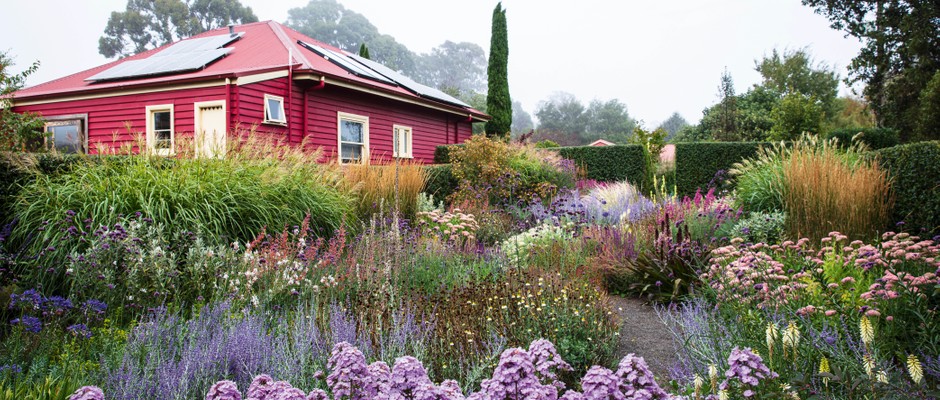
An Australian garden with a magpie approach to planting
Australian gardener Simon Rickard is inspired by the great gardens of Britain but, rather than slavishly copying them, uses plants that will thrive in the Central Highlands of Victoria. Words by Natasha Goodfellow, images by Claire Takacs.
Imagine Australia and, chances are, you’ll picture somewhere hot, sunny and within striking distance of a beach. Even if you know that Melbourne has a cooler, rainier climate, you may still be surprised to learn that just over an hour northwest, in Victoria’s Central Highlands, things can turn very cold indeed, with wet, snowy winters and temperatures sometimes as low as -7°C. Summers, on the other hand, are brief and can ricochet between relatively cool and extremely hot. “Think of the South of France in August,” says Simon Rickard, who has made his home here in the small town of Trentham. “It can be brutal.”
An avid gardener since childhood, for seven years Simon was head gardener at two of the flagship gardens of The Diggers Club (an Australian organisation similar to the RHS), St Erth and Heronswood, and now designs gardens, leads garden tours and lectures all over the globe. He is also a talented musician specialising in Baroque and Renaissance bassoons, and his studies, which included four years in Europe, gave him the opportunity to visit many of the gardens he had read so much about. “Great Dixter, Sissinghurst, Kew… British gardens are the best in the world,” he says.
What A gardener's garden planted for year-round interest with a vegetable garden, a woodland garden and a spectacular privy garden.
Where Victoria, Australia.
Size Half an acre.
Soil Rich basalt loam.
Climate Cold, wet winters with cool, increasingly dry summers with occasional temperature spikes and considerable variation between years.
Hardiness zone USDA 9a (Sunset Zone 15).
It was the spirit of these gardens that Simon wished to conjure when he started to make a garden here in Trentham 18 years ago. The plot was completely bare, save for a covering of grass. “I began by earmarking parts of the garden for different purposes,” says Simon. “The vegetable and fruit garden obviously had to have full access to the sun. I wanted the front garden to look impressive from the road, and I wanted to create a more private space behind.”
Then came the planting, informed by two guiding principles. “I wanted a garden that looked good for much of the year, so shape and foliage were always going to be more important than colour,” says Simon.
Second, in selecting his plants he has not adopted the plants he saw growing in British gardens, but has instead embraced the British approach to garden making, with far happier results. “I think too often Australians learn the wrong lessons from British gardens,” he says. “We tend to obsess over Russell lupins or delphiniums, which just can’t cope in our climate, and in so doing, set ourselves up for failure. For me, the real strength of British gardens is the selection of plants from similar climates to the UK’s, all brought together in a unique aesthetic. That’s what I’ve tried to do here.”
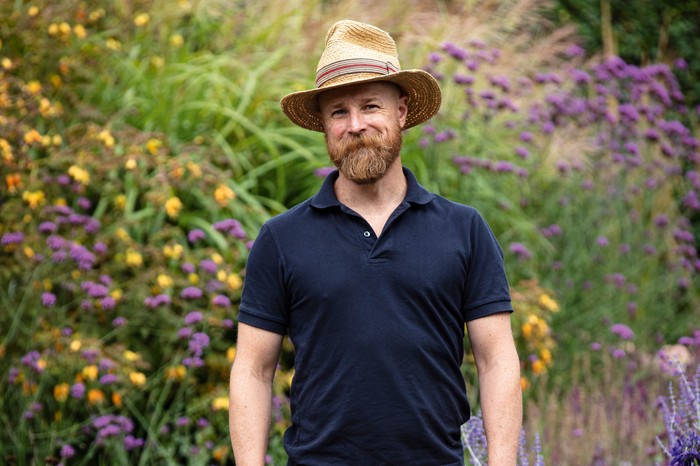
Pointing out that his conditions are more similar to that of Cape Town in South Africa than Sydney or Brisbane, he has taken a magpie approach, identifying climates similar to his own – the mountains of Turkey and Greece, the Chilean Andes and the east coast of New Zealand’s South Island, for example – and selecting plants that catch his eye. So, a trio of Mediterranean Cupressus sempervirens ‘Glauca’ zig-zag down the plot, adding height and structure, next to repeated clumps of New Zealand Cordyline australis Purpurea Group and Phormium ‘Anna Red’. Daphne bholua, the Nepalese paper plant, North American Cornus sericea ‘Baileyi’ and Corsican Helleborus argutifolius, meanwhile, ensure plenty of winter interest.
Despite concerns in some quarters about the attractiveness of exotic plants to native wildlife, Simon reports that his wild garden visitors seem to positively thrive on the mix. “Native animals cannot read a plant’s passport, and they’re just as happy to suck nectar from Oriental lilies as they are from a native grevillea,” he says.
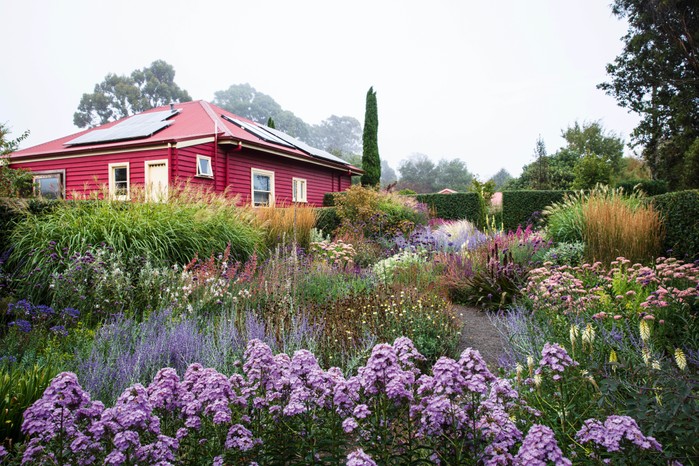
In summer, the hedged ‘privy garden’, based on an Arts and Crafts garden room, is the undoubted star of the show. Enclosed by hedges of glossy-leaved Escallonia 'Iveyi', it is a mass of densely planted ornamental grasses and perennials with only the slimmest pathway snaking through. “I wanted to make it just about the viewer, the flowers and the sky,” says Simon. This is also the space where Simon feels freest to challenge himself, experimenting with colours and combinations. “I’ve got a bit of everything in there,” he says, smiling broadly. “Acid green; lilac; purples; shocking, toxic pink; yellow… and it makes me really happy. It’s clashing, a little tasteless perhaps, but it’s just joyous."
Grasses include Miscanthus sinensis ‘Silberfeder’, Cenchrus longisetus and Calamagrostis x acutiflora ‘Karl Foerster’, which add softness and movement to the vibrant selection of perennials, including Phlox paniculata ‘Hesperis’, Eucomis comosa ‘Oakhurst’ and Hylotelephium Herbstfreude Group.
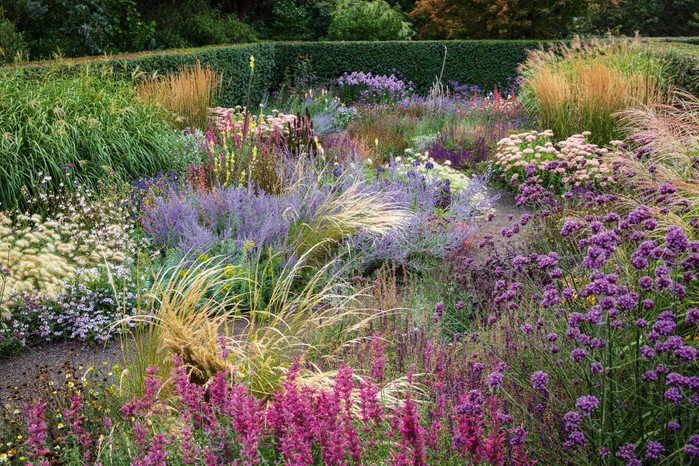
Simon loves this corner of the ‘privy garden’, with its bold plantings of blue Salvia yangi ‘Little Spires’,
which Simon describes as a “palate cleanser”, alongside the shocking-pink tender perennial Agastache ‘Nadine’, the tall, purple Verbena bonariensis and low-growing, lilac Verbena rigida f. lilacina ‘Polaris’, while Verbascum bombyciferum ‘Polarsommer’ and Kniphofia ‘Little Maid’ add unexpected hits of yellow.
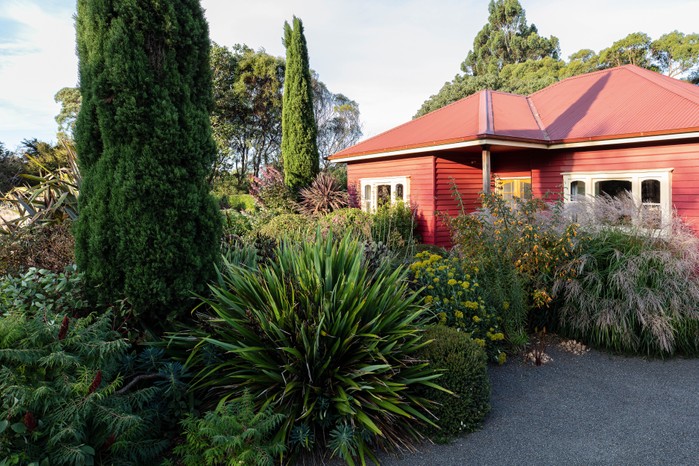
Designed for maximum impact from the street, Simon’s front garden looks good for most of the year with long-lasting evergreen shrubs and perennials chosen primarily for their form and foliage, such as the tall Cupressus sempervirens ‘Glauca’ and the large New Zealand flax Phormium colensoi.
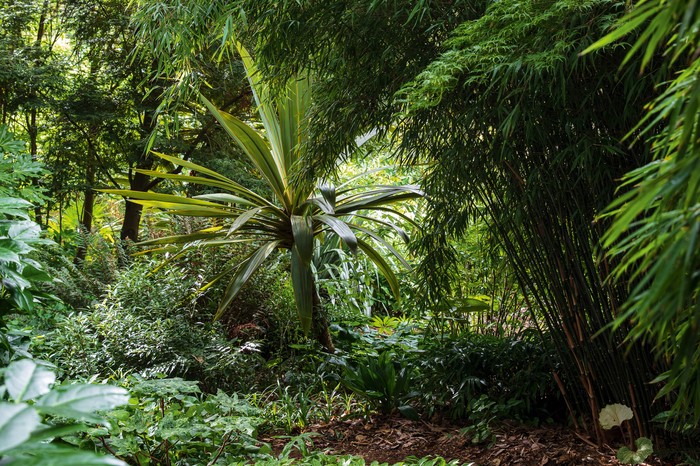
Simon’s woodland garden continues his theme of successfully mixing plants from different regions. A spectacular Cordyline indivisa, native to New Zealand, grows below the tough Asian bamboo, Fargesia scabrida. At ground level the wonderfully mottled Podophyllum ’Spotty Dotty’ mingles with Disporopsis pernyi, alongside a mix of ferns and hellebores.
Authors
Claire Takacs is an Australian garden and landscape photographer who seeks to be surrounded by beauty always.

Niwaki bundle worth £57 when you subscribe
Subscribe to Gardens Illustrated magazine and claim your Niwaki bundle worth £57
*UK only
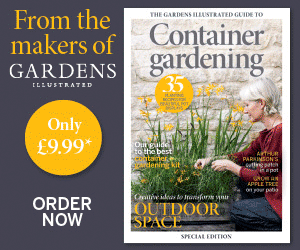
Container Gardening Special Edition
The Gardens Illustrated Guide to Container Gardening.
In this special edition, discover colourful flower combinations and seasonal planting schemes for pots designed by leading plantspeople, and essential know-how for container gardening success. Just £9.99 inc UK p&pBy entering your details, you are agreeing to our terms and conditions and privacy policy. You can unsubscribe at any time.
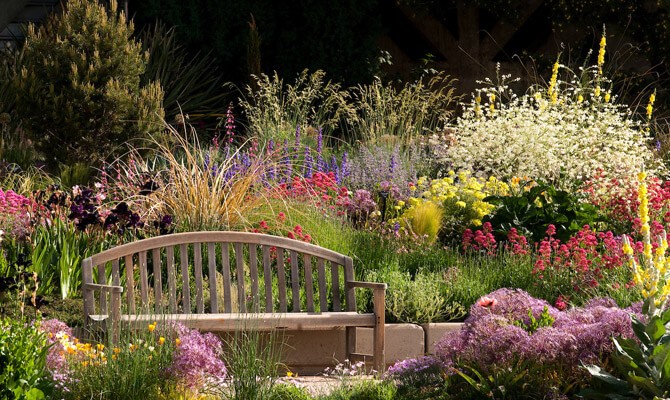
Gardens of the Globe
From botanical wonders in Australia to tranquil havens closer to home in Ireland, let this guide help you to discover some of the most glorious gardens around the world
By entering your details, you are agreeing to our terms and conditions and privacy policy. You can unsubscribe at any time.





